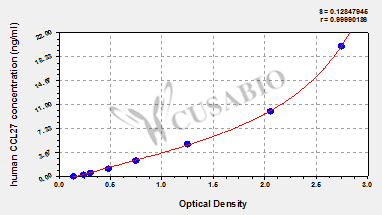This human CCL27 ELISA kit employs the quantitative sandwich enzyme immunoassay technique to measure the levels of human CCL27 in multiple samples, including serum, plasma, or tissue homogenates. It also uses the enzyme-substrate chromogenic reaction to visualize and analyze the analyte levels through the color intensity. The intensity of the colored product is in direct proportion to the CCL27 levels in the sample and is measured at 450 nm through a microplate reader.
CCL27 is an inflammatory chemokine mainly expressed by skin keratinocytes. It is associated with homing of memory T cells to sites of inflammation. CCR10 is the only known receptor for CCL27. Studies have shown that CCL27/CCR10 axis primarily functions in aiding the establishment of tissue-resident lymphocytes and maintenance of skin immune homeostasis. CCL27 expression is linked to normal skin development and keratinocyte differentiation. In healthy skin, CCL27 expression was predominantly detected in keratinocytes of the epidermis and hair follicles (HF) in both humans and mice. CCL27 expression is inhibited in the lesional skin of various skin inflammatory diseases such as psoriasis, hidradenitis suppurativa (HS), and alopecia areata. Kraynyak et al. have shown that CCL27 has adjuvant activity, enhancing immune responses to HIV-1 and SIV antigens.






